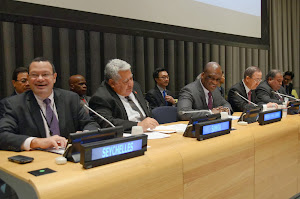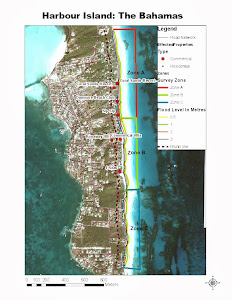In 1979, when Richard Branson bought the 74-acre Necker Island in the British Virgin Islands, he paid less than $300,000. It was untouched, undeveloped, inhabited only by birds and jungle critters. Back then, no one worried a wit about carbon emissions, ocean acidification, rising sea levels. To bring electricity to his island retreat Branson, like virtually everyone else on the small islands of the Caribbean, installed diesel generators.
 |
| Necker Island |
As far as fuels go, diesel is hard to beat. It’s easy to transport and contains a lot of energy in a small volume. It’s already ubiquitous in the islands as fuel for boats. And it’s never been cleaner, with U.S. government standards limiting sulfur content to no more than 15 parts per million. For decades, diesel was simply the way to go.
But Branson wants to change that. Because running on diesel means that the cost of electricity on Caribbean islands averages about 50 cents per kwh, about five times what it is on the mainland United States.
In early February, Branson leveraged his star power to convene a three-day meeting of dignitaries from 13 Caribbean nations including the Virgin Island, St. Kitts & Nevis, Turks & Caicos and the Cayman Islands. While enjoying both Necker Island and Branson’s neighboring Moskito Island, they discussed the costs of powering their island homes and the economics of switching over to clean, green renewable energy.
Working with The Carbon War Room (an anti-carbon group he co-founded) as well as the energy experts at the Rocky Mountain Institute, Branson is promoting something called the 10 Island Renewable Challenge. The idea is to get the island nations of the Caribbean to switch away from diesel. The argument is simple: going carbon-free won’t just help keep the air clean and reduce greenhouse gases in the atmosphere — it will save lots of money too.
To help the cause, Carbon War Room and RMI have worked with the World Bank and the U.S. Overseas Private Investment Corporation to earmark $300 million for new renewable energy projects in the islands.
Necker Island will be the first to make that shift. Within three years Branson aims to be using solar and wind, with battery backup, to provide for 80% of Necker’s energy needs, with a long-term goal of 100%. Branson has contracted with NRG EnergyNRG Energy to build Necker’s renewable micro-grid.
“What we hope to do is use Necker as a test island to show how it can be done,” said Branson in a statement. “The only way we’re going to win this war is by creative entrepreneurship.”
Among the world’s CEOs and billionaires, Branson has real environmentalist cred. Sure the founder of Virgin Records, Virgin Airways, and now Virgin Galactic is responsible for millions of tons of carbon emissions over the years. But he’s been trying to make up for it. As early as 2008 his airline flew a Boeing Boeing 747 from London to Amsterdam on a low-carbon fuel made of babassu oil and coconut oil. He’s also a backer of the new solar-powered airplane SolarImpulse.
Jon Creyts, a managing director at the Rocky Mountain Institute, was in attendance at the conference, and shared with the group RMI’s research on just how much sense it makes for the islands to shift from diesel. According to Creyts, when you factor in the costs of fuel, transmission and capital investment, the average cost of electricity in the Caribbean ranges from 32 cents to 65 cents per kwh. That’s as much as five times what the average American pays for electricity. Most of that cost is in the diesel; a 1,000 kw diesel generator running at 100% capacity gulps about 70 gallons in an hour. That equates to .07 gallons per kwh. At current diesel prices in the Virgin Islands of $3.50 per gallon that comes out to 25 cents per kwh in diesel.
Compare that with the U.S. Energy Information Administration’s figures for the all-in costs of other generation methods. Gas turbines can do about 7 cents per kwh, offshore wind 22 cents, and solar photovoltaic 14 cents.
The increased costs of building in isolated locations might add a couple cents per kwh, but overall it’s hard to argue that the islands should stick with diesel. Even before Richard Branson’s new efforts, Aruba had worked with RMI and Carbon War Room to institute a green energy revolution. In recent years Aruba invested $300 million to build a 20-turbine wind farm rated at 30 mw that meets 20% of the island’s power needs. It replaced its old electric turbines with more efficient models, and is building a solar panel park. Since beginning its efforts in 2006 Aruba has reduced its imports of heavy fuel oil from 3,000 barrels per day to 1,700 barrels, saving some $50 million a year.
The U.S. Virgin Islands had taken tentative steps toward solar, signing long-term deals with solar developers to buy power from three systems with peak capacity of 18 mw. That will meet about 18% of the territory’s peak demand. A 20-year deal with Toshiba Toshiba will cost an average of 17 cents per kwh. The islands also require that all new construction use solar power for hot water heating.
It sounds good, but even on the islands, reality is a challenge. According to a study last year by the National Renewable Energy Laboratory, solar developers need an average of 10 acres of land to put up 1 mw of solar panels. That implies that if the U.S. Virgin Islands were to go totally solar and replace its two big oil-burning generators that put out about 100 mw around the clock, they would likely need at least 1,500 acres of land (or roofs) covered in panels, a bunch of wind turbines to provide power at night, plus some sort of ingenious energy storage system smooth out the peaks. That could be doable on St. Croix, which consists of about 53,000 acres and the 1,500-acre Hovensa oil storage terminal on its south side. A 1,100-acre chunk of land adjacent to the terminal is now in process of being cleaned up and redeveloped.
An even better idea for the very long term is for these islands to tap their enormous and endless domestic energy opportunity: geothermal. Most of the islands in the eastern Caribbean were formed by volcanic action. The volcano on Montserrat erupted violently in 1997, killing 19. Because they are located close to the boundaries of two tectonic plates, the islands have plenty of natural volcanic heat that they could tap at relatively shallow depths. Already Iceland Drilling Company, based in the world’s capital of geothermal energy, is reportedly working on exploratory geothermal projects in Dominica and Montserrat. Projects are also being drawn up for Nevis and St. Vincent.
In time each of these islands could be powered by steam turbines running on virtually endless supplies of cheap energy harnessed from the Earth’s own internal furnace.
But solar, wind and geothermal are all expensive. Another part of the challenge, says Creyts, who was a McKinsey consultant before joining RMI, is that most of the Caribbean islands have pretty lackluster credit ratings and not much borrowing capacity. Indeed, Jamaica, St Kitts-Nevis, Grenada, Barbados and Antigua and Barbuda all have public debt loads approaching or surpassing 100% of GDP. That’s why it was so vital to get the World Bank and OPIC on board to help arrange low-cost financing.
There’s no shortage of potential projects for the islands to pursue, with energy-hungry hotels, hospitals and schools offering the lowest-hanging fruit. Naturally, there’s plenty of corporate partners ready to help the islands make the shift. Executives from Philips, Johnson Controls, Sungevity, Vestas and NRG were present at the Necker Island retreat.
There’s some incentive for these island nations to think about moving a little quicker in their renewables plans. Many Caribbean nation’s have joined the PetroCaribe pact created by Venezuela’s late President Hugo Chavez, whereby Venezuela has for years sent them discounted oil. Though Chavez’ successor Nicolas Maduro has continued the oil discounts, there is concern that amid Venezuela’s slow-motion economic collapse the largesse will soon end, forcing the islands to pay more on the world market.
Renewable, carbon-free energy doesn’t yet make economic sense in the most densely inhabited parts of the world that are already well served by reliable energy sources. But islands like these represent a motivated laboratory of energy evolution. In time, the lessons learned in the islands will be ripe for application across the other energy-starved corners of the world. More





